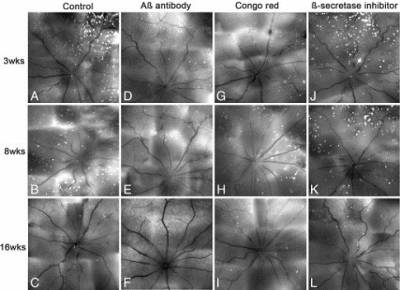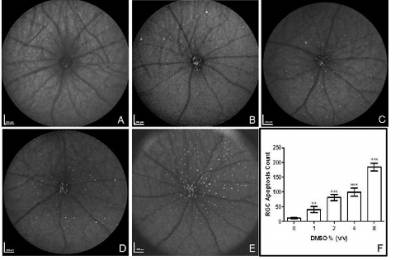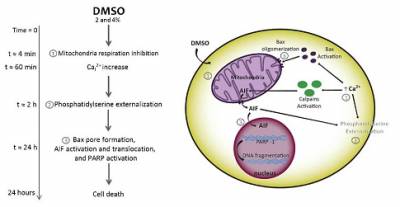Another important aspect of the groups's work is the mechanisms by which nerve cell apoptosis and loss occurs.
error message: 'NoneType' object has no attribute 'split'
We recently showed that some RGC death in glaucoma models was associated with the deposition of the protein Beta-Amyloid - the same protein which forms the plaques which are characteristic of Alzheimer's Disease.
We also showed that glaucomatous RGC apoptosis could be reduced using therapies that targeted Beta-Amyloid.

Targeting Aβ in experimental glaucoma. In vivo DARC images show the effects of different approaches targeting Aβ on RGC apoptosis in OHT rats. Eyes were assessed at 3 (A, D, G, and J), 8 (B, E, H, and K), and 16 (C, F, I, and L) weeks after IOP elevation with treatments of Aβab (D-F), CR (G-I), and βSI (J-L), respectively, compared with control (IgG1, no antibody; A-C). The white spots represent apoptotic RGCs labeled by annexin 5. From Proc Natl Acad Sci U S A. Aug 14, 2007; 104(33): 13444-13449.
Recently identified concerns
Our group has also recently identified concerns regarding the use of the generically used solvent, DMSO, which highlight safety concerns of using low concentrations of DMSO as a solvent for in vivo administration and in biological assays.
We demonstrated that DMSO induces retinal apoptosis in vivo at low concentrations (5 µl intravitreally dosed DMSO in rat from a stock concentration of 1, 2, 4, and 8% v/v) using the DARC technique.

DMSO toxicity in vivo: effects on RGC apoptosis. In vivo DARC images obtained using an HRA Spectralis (Heidelberg Engineering), show the effects of 5 .l of intravitreally administered DMSO at indicated stock concentrations of 0, 1, 2, 4, or 8% (v/v) on RGC apoptosis 2 h following intravitreal injection of fluorescently labeled annexin V (Anx-F). White spots represent apoptotic RGCs labeled by Anx-F. A-E) Wide-angle in vivo retinal images: PBS control (A), 1% DMSO (v/v; B), 2% DMSO (v/v; C), 4% DMSO (v/v; D), and 8% DMSO (v/v; E). Scale bars . 200 .m. F) Statistical analysis of the number of Anx-F-positive cells after intravitreal injection of PBS or DMSO. Error bars represent sem. *P . 0.05; **P . 0.01; ***P . 0.001. From FASEB J. 2014 Mar;28(3):1317-30.
Results of the study
The study suggests that DMSO induces apoptosis via inhibiting mitochondrial respiration and increasing intracellular calcium. DMSO crosses biological membranes and has been reported to induce apoptosis through mitochondrial depolarization as visualized using JC-1 previously.
The results of our study suggested a similar process occurs in RGCs, as inhibition of mitochondrial respiration was observed after 1, 2, and 4% (v/v) DMSO application. We propose that the mechanism by which DMSO induces cell death involves inhibition of mitochondrial respiration leading to decreased oxygen consumption within minutes of application.
Moreover, elevation of cytosolic calcium and phosphatidylserine externalization occur. Calcium has been implicated in phosphatidylserine flipping previously and is known to induce calpain activation. Calpain acts to induce the release and redistribution of AIF to the nucleus.
This could occur through Bax translocation from the cytosol to the mitochondria. Increased levels of Bax in mitochondrial fractions and decreased levels in the cytosolic fractions accordance with Bax oligomerization and pore formation indicating that AIF translocation from mitochondria is via Bax pore formation.
AIF has been implicated in phosphatidylserine externalization through the interaction with scramblase Scrm-AIF can in addiction translocate to the nucleus cause DNA fragmentation and activation of leading to cell death.

Proposed pathway for the induction of neuronal cell death in the eye by low doses of DMSO. DMSO (2-4% v/v) inhibits mitochondrial respiration and stimulates intracellular calcium transients. This leads to phosphatidylserine externalization and the earliest stages of apoptosis. Bax oligomerization induces mitochondrial permeabilization, and AIF activation and translocation. Apoptosis continues through PARP activation resulting in cell death. Timeline shown is based on in vitro results. From FASEB J. 2014 Mar;28(3):1317-30.
Unexpected finding
Our finding that at concentrations <10% (v/v), DMSO is toxic is unexpected. These results underline safety concerns of using low concentrations of DMSO as a solvent for in vivo administration of numerous molecules, which we show not to be safe. We believe that the scientific community should question the use of DMSO in biological assays, with particular relevance to delivery to neuronal cells. Finally, due to the broad number of drugs dissolved in DMSO, we believe these results have widespread implications, not only in the eye and in neuroscience, but also throughout the whole body.
 Close
Close

